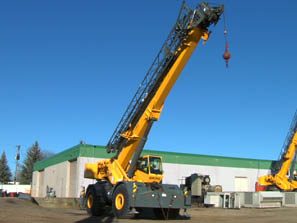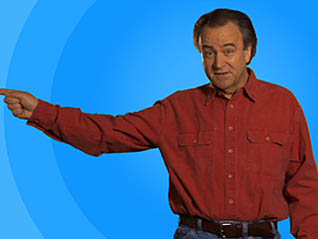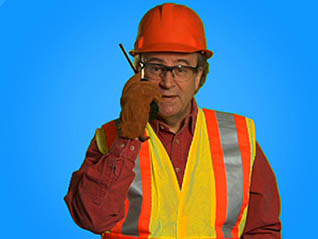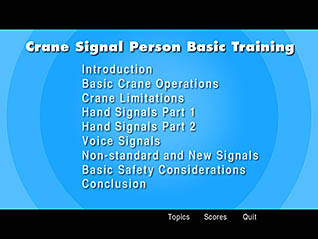Overhead: Crane Signal Person Basic Training
- Product ID
- apiccspt
- Training Time ?
- 44 to 88 minutes
- Language(s)
- English
- Video Format
- Standard Definition
- Required Plugins
- MasteryNet Player
- Lesson Interactions
- 32
- Quiz Questions
- 37



Cranes allow for the movement of large loads around a construction site. The functionality of the equipment makes cranes indispensible; however immense safety risks accompany their value. A crane signal person must provide direction to the operator, providing an extra set of eyes on the site. The industry-accepted hand and verbal commands follow regulations such as ASME B30.5-2007 and OSHA 29 CFR 1926.1419-1422 and 1926.1428.
These industry-accepted commands must become second nature to a signal person, to ensure clear communication between the signal person and crane operator. This online training explains basic crane operations and limitations. The course demonstrates various hand and verbal signals, so learners can identify and perform the signals. Information on non-standard and new signals is included, as well as some basic safety considerations to be aware of when working with or around cranes.
A crane operator is only as good as the signal person directing them. Help keep an efficient and safe work site with this online training.
![]() This course is in the Advantage™ format, to read about Advantage™ features click here.
This course is in the Advantage™ format, to read about Advantage™ features click here.



- Install on any SCORM LMS
- Rich multimedia presentation with interactions and quiz
- Print certificate and wallet card
- You have 30 days to complete the course
Anyone working as a crane signal person, and others working with or around cranes
- Background Information
- Basic Crane Operation
- Crane Load Limits
- Load Radius
- Boom Deflection
- All Hand Signals
- Signaling From Operator's Perspective
- Voice Signaling Guidelines
- Non-Standard and New Signals
- Basic Safety Practices
- Conclusion
-
Explain the basic components and function of mobile and tower cranes
- Describe function of crane booms, cables and counterweights.
- Explain the purpose of crane outriggers.
- Describe function of tower crane jib and trolley.
-
Identify crane limitations related to load limits and boom deflection
- Explain how lowering the boom decreases the crane load limit.
- Describe how lowering the boom decreases the load limit.
- Define load radius.
- Define boom deflection and explain its hazards.
-
Correctly identify and perform the hand signals in this lesson.
- Correctly identify the hand signals for Stop, Emergency Stop,Hoist, Lower, Move Slowly, Swing, Dog Everything, Use Main Hoist,Use Whipline, Boom Up, Boom Down, Boom Down and Raise the Load,Boom Up and Lower the Load, and Travel.
-
Correctly identify and perform the hand signals in this lesson.
- Correctly identify the hand signals for Travel - Both Tracks,Travel One Track, Telescope Out, Telescope In,Telescope Out (One hand signal), Telescope In (One hand signal),Tower Travel and Trolley Travel.
-
Correctly and clearly communicate verbal signals to the crane operator.
- Explain the three key elements included in verbal signals and their order.
- Recognize that verbal function signals should be the same as the standard hand signals.
- Describe how signals to stop always have the function first, followed by stop.
-
Correctly utilize new or non-standard signals.
- Describe crane personnel that must understand any new or non-standard signals.
- Identify where to find OSHA guidelines for new or non-standard signals.
-
Practice fundamental signal person safety procedures.
- Describe the PPE to be worn by a signal person.
- Explain basic safety precautions a signal person should practice.
© Mastery Technologies, Inc.




